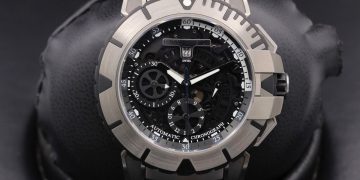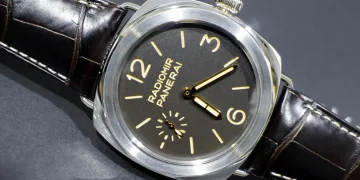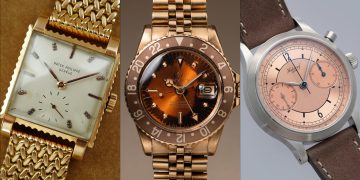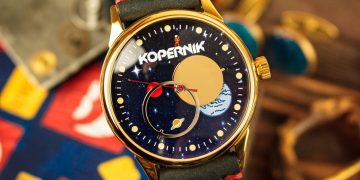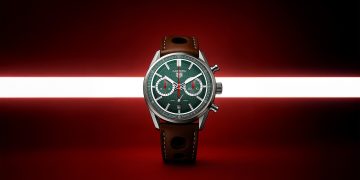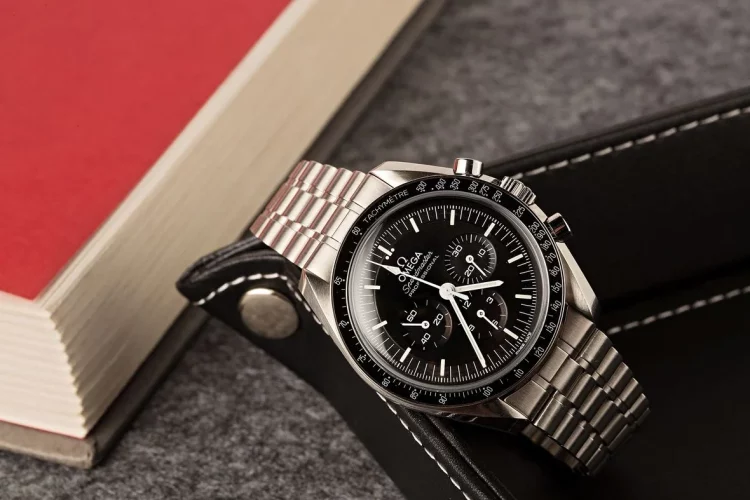Introduction
When it comes to iconic luxury watches, the Omega Speedmaster and the Rolex Submariner stand at the apex of the watchmaking world. Both timepieces have not only become symbols of their respective brands but have also played significant roles in their respective fields — the Speedmaster in space exploration and the Submariner in the world of diving. While they serve different purposes, their legacies have become intertwined with history, culture, and the modern luxury watch market.
In this article, we’ll delve into the brand history and the evolution of the Omega Speedmaster and Rolex Submariner, examining how both watches came into existence, their cultural influences, and their lasting impact on the watch industry and society. By the end of this article, we’ll have a deeper understanding of what makes each of these timepieces exceptional.
1. The Origins of the Omega Speedmaster
The Omega Speedmaster was first introduced in 1957 as part of Omega’s “Professional” line of watches. Initially designed as a chronograph for motorsports enthusiasts, the Speedmaster had a tachymeter scale bezel, which allowed users to measure speed over a known distance. However, it would soon become far more famous for a completely different reason.
Early Design and the Birth of the Speedmaster
Omega had been making chronographs for decades before the Speedmaster was created, but the Speedmaster’s unique design, with its high-contrast dial, pusher buttons, and tachymeter bezel, made it stand out. The first Speedmaster, Reference CK2915, featured a manual-winding chronograph movement — the Caliber 321 — and a stainless steel case. The watch was a hit in motorsport circles, but its journey would soon take a different direction, which would ultimately define its legacy.
The Space Race and the Moonwatch
The Speedmaster’s most significant claim to fame came in the early 1960s when NASA began looking for a watch that could withstand the extreme conditions of space. After rigorous testing, the Omega Speedmaster was chosen in 1965 as the official chronograph for NASA astronauts. This decision would mark the start of the Speedmaster’s long association with space exploration.
The Speedmaster became the first watch worn on the Moon during the Apollo 11 mission in 1969. Buzz Aldrin wore the Speedmaster when he became the second person to walk on the Moon, cementing the Speedmaster’s legacy as the “Moonwatch.”
Speedmaster Today
Today, Omega continues to produce the Speedmaster, maintaining its connection to the original 1957 design but evolving it with modern movements like the Caliber 3861 (Master Chronometer). It remains a symbol of human ingenuity and a nod to space exploration.
2. The Origins of the Rolex Submariner
The Rolex Submariner, first introduced in 1953, is often regarded as the first true dive watch. Created specifically for underwater exploration, it was designed to withstand the pressure of deep-sea diving and offer unparalleled reliability. Like the Speedmaster, the Submariner would become a mainstay in its own field, though its history took a different turn.
Design and Purpose
Before the Submariner, dive watches were primarily designed for leisure and water sports. Rolex aimed to make a more robust timepiece that could survive extreme diving conditions. The Submariner’s rotating bezel allowed divers to track their dive times, while the watch’s water resistance (initially rated at 100 meters) set it apart from other watches of its time.
The first Submariner model, the Ref. 6204, had a self-winding automatic movement — an innovation in the diving watch market at the time. Rolex’s emphasis on high-precision movements and superior craftsmanship quickly made the Submariner a favorite among both professional divers and watch enthusiasts.
Becoming an Icon of Luxury and Performance
While the Submariner was initially designed as a tool watch for divers, it soon transcended its utilitarian roots to become an icon of luxury and style. The Submariner’s clean, unassuming design, combined with Rolex’s brand reputation for excellence, turned the watch into a symbol of success and sophistication. Throughout the 1950s and 1960s, the Submariner found a place on the wrists of film stars, athletes, and wealthy individuals, making it as much a statement piece as a diving tool.
Submariner Today
The Rolex Submariner is now available in various models, including the Submariner Date and the Submariner No Date, offering versatility in design while retaining the core features that made the watch famous. It is known for its Cerachrom bezel, 904L steel, and the Caliber 3235 movement, which delivers unparalleled performance.
Today, the Submariner is a benchmark for luxury dive watches, with many other brands trying to emulate its robust functionality and elegance. Its impact on the watch industry has been profound, and its legacy as one of the most important and influential watches in history continues.

3. Omega Speedmaster: A Legacy in Space and Time
The Omega Speedmaster holds a unique place in watch history due to its direct connection with space exploration. Its status as the Moonwatch is unparalleled, and it remains an enduring symbol of human ambition, precision engineering, and the spirit of exploration.
The Moon Landing and the Speedmaster’s Role
The Apollo 11 mission, which resulted in the first manned moon landing, solidified the Speedmaster’s iconic status. NASA’s grueling selection process tested several timepieces, but only the Speedmaster passed all the necessary tests for extreme environments. The Speedmaster’s ability to operate in zero gravity, extreme temperatures, and in the vacuum of space made it the perfect companion for astronauts.
This historical moment is celebrated with every new generation of the Speedmaster, as Omega continues to produce versions that pay homage to its lunar legacy. The connection to the moon has made the Speedmaster a symbol of human achievement and exploration.
Cultural Significance and the Speedmaster’s Enduring Popularity
Beyond space exploration, the Omega Speedmaster has been embraced by watch collectors, adventurers, and enthusiasts for its durability and history. The watch has been worn by countless notable figures, and its clean, legible design remains relevant in today’s fashion world.
The Speedmaster’s role in space exploration has also ensured its place in pop culture. Whether appearing in movies or being worn by astronauts on the International Space Station, the Speedmaster is more than just a watch—it is a symbol of humanity’s quest for knowledge and adventure.
4. Rolex Submariner: The Ultimate Dive Watch
The Rolex Submariner has long been regarded as the quintessential dive watch, but its appeal goes far beyond its initial function. Its clean design, coupled with Rolex’s reputation for durability and precision, made it an instant success when it was introduced in 1953.
Rolex’s Commitment to Precision and Innovation
Rolex’s commitment to precision has made the Submariner an industry benchmark. Its automatic movement was groundbreaking for a diving watch, and the company’s patented rotating bezel set it apart from the competition. The Submariner’s design, while simple, has remained virtually unchanged since its introduction, which speaks to the timelessness of the model.
Submariner as a Luxury Icon
As Rolex’s most recognized and sought-after model, the Submariner is now seen as a status symbol. Celebrities, politicians, and royalty have helped elevate the Submariner’s stature in the public consciousness. The watch’s stainless steel construction, Cerachrom bezel, and caliber movements offer both practicality and elegance, which have ensured its appeal to those who demand the best in both functionality and luxury.
5. Brand Evolution and Marketing: Omega vs. Rolex
Both Omega and Rolex have relied heavily on brand heritage and marketing to establish their dominance in the luxury watch market, but their strategies differ in several ways.
Omega’s Marketing and Enduring Legacy
Omega’s marketing strategy has heavily emphasized its connection to historical events, such as the Apollo missions and the Speedmaster’s role on the moon. This story has proven to be timeless, attracting both watch enthusiasts and space exploration fans. Omega has also embraced modern technological innovations, including its Master Chronometer movement and anti-magnetic technology.
Rolex’s Cult of Exclusivity
Rolex, on the other hand, has built its brand around exclusivity, luxury, and precision. While the Submariner was originally designed for professional divers, it has become a symbol of wealth, success, and status. Rolex’s tight control over its distribution and limited supply has further enhanced the mystique of the brand, creating a demand far greater than its availability.
6. Conclusion: Comparing the Speedmaster and Submariner
The Omega Speedmaster and Rolex Submariner are two of the most iconic watches ever made, each representing its respective brand’s commitment to precision, design, and innovation. The Speedmaster’s rich history in space exploration and its strong connection to human achievement set it apart, while the Submariner’s enduring legacy as the definitive luxury dive watch speaks to Rolex’s ability to blend performance with elegance.
In the end, the choice between the two comes down to what you value more: the exploration spirit and heritage of the Speedmaster or the legendary craftsmanship and luxury association of the Submariner. Both are milestones in the world of horology, offering not only exceptional performance but also deep cultural significance.



